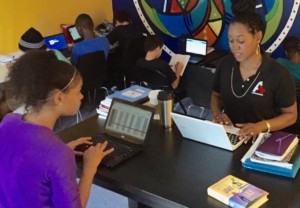Improving Organizational Culture: Discovering Your Core Strengths

We believe that a positive organizational culture can take an organization from good to great. Given the importance of developing healthy leadership and organizations, we have been sharing a few of the tips our team has learned over the years. In our last post, we discussed the importance of finding your personal and organizational why. This is a great reflection exercise for teams to do to keep ever present the reasons why they are embarking upon their work.
Reaffirming why your organization exists and why you go to work each day, is a crucial exercise for developing a healthy organizational culture. But what happens after you’ve done that? Organizations are comprised of unique individuals with varying strengths and talents who are all working together to carry out the organization’s mission and vision. So consider for a moment: Do you know the strengths of all the members of your team? Are you maximizing them? Are you growing their strengths and helping them develop new ones? What happens when team members with varying strengths collaborate with one another? Are their strengths amplified? Is there a potential conflict because styles are different?
Personality and strengths assessments are great tools to help you answer the above questions. Before administering one of these assessments, it is critical to understand why you are administering it and what you will do with the results. There are numerous tools that you can use and the two tools highlighted below have been utilized by our team. Along with each tool, we’ve also provided scenarios to outline why you may want to embark on this type of exercise with your team.
Leadership Transitions and Discovering Team Strengths
The Why. A leadership transition is often a great time for a new leader to understand the unique strengths and areas of improvement of each of their team members. This exercise can be especially helpful if the team is looking for direction and guidance, has gotten into a culture of not collaborating or communicating with their peers and/or you’ve identified areas of improvement and want to give an individual the opportunity to self-identify those areas and learn more about them.
If any of the above scenarios are true at the time of the leadership transition, it is important to work on building trust and openness with the team first before embarking on a strength finder assessment. The reason being is that the team could perceive the assessment in the wrong way and think that as a new leader, you are using the assessment against them rather than using it as a positive. We think planning for the start of a school year is another great reason to do a skill assessment as well.
The Process. No matter what assessment you ultimately decide on, it’s a good practice to share with the team why you’re using a skills/strength finder tool. Is it to provide you and the individuals, a better understanding of their strengths/areas of improvement? If so, what will you do with that information? Could it be used to identify professional development opportunities or utilize their strengths on new projects? Perhaps the assessment is being used for individuals to get a pulse on their personal strengths leading into a team building exercise, or just for their own growth and development.
Another reason assessments are often used is to chart how different members of the team may work together. Team building can be built around the results and as a leader, you can keep an eye out for who may or may not work well together given their results and offer support as needed.
Of course, there may be reasons for administering the assessment which you don’t fully disclose with the team, but the point is there should be a level of transparency for doing the exercise. If there’s not, the team may come to their own conclusions and that could lead to unnecessary stress or fear regarding their position/role within the organization.
The Tool. A beneficial tool for both leadership and employees is the True Tilt Profile by Tilt 365 given it identifies strengths, along with also identifying steps one can take to both strengthen what they’re already good at and further develop areas that need work. The True Tilt Profile is described as, “providing deep, personalized insights and offers actionable suggestions to help you grow. Helps you understand and appreciate your true self – Articulates not only what you do, but why you do it. Results are reported in a memorable visual framework that allows comparison of your patterns to others to help you communicate better. Describes how you adapt to fit each situation, not just your personality “type”. Gives you the tools you need to effectively use your strengths in different situations.” The profile also comments on how your personality type interacts with other types.
If you were using this tool to help individuals identify areas of growth, it’s recommended that you review the results with them and talk about action planning based on the suggestions given in the report. This creates personal accountability but also allows you to support the employee as they’re working on their own development. Periodic check-ins on progress will be beneficial.
Given the tool identifies how individuals of varying personalities may interact with one another, it’s often helpful to have the team talk about their results and share how they work and communicate. This can help foster a sense of mindfulness among the team and how to potentially work best with one another. It also allows the leader to have an idea of how team members may react when working together, and offer support and guidance when and if needed.
Incorporating Strength Finding into Team Development
The Why. At some point, most of us have taken a strength finder or personality assessment, but these assessments are often ones we don’t commit to memory or we don’t keep the results easily accessible. It’s always a good idea to be reminded of our strengths and where development is needed since these areas may shift over time. If an assessment is being used as a refresher, a great time to administer it is before a retreat or team building event. In addition to having the team share some of their results at one of these sessions, the agenda could also be built with the results in mind and provide an opportunity for the team to build upon their strengths or work on the areas of development in a team setting.
Of course, as a leader you would still want to follow-up individually with team members to talk about their unique results and where you can support their growth and development.
The Tool. The Enneagram personality assessment is one of the most in-depth and popular assessments. While a Google search will populate many Enneagram assessments, a very well-known and respected version is the Riso-Hudson Enneagram Type Indicator (RHETI®) by the Enneagram Institute. The RHETI “is a scientifically validated, forced-choice personality test with 144 paired statements.” The assessment, “produces a full personality profile across all nine types. This provides you with a unique portrait, indicating the relative strengths and weaknesses of the nine types within your overall personality.”
The comprehensiveness of the RHETI Enneagram makes it a great tool to use to identify areas where you are strong and also areas that may need additional development. Given the time it takes to complete the test and the very detailed report that is provided upon completion, it is once again important to have a plan in place for why this assessment is being used with the team. It’s often helpful to backward map to determine the why for this type of exercise. What will the Enneagram help you and the team discover? Why is that important? What happens after the discovery? How will the results be utilized? Answering these questions and sharing them with the team, will help create a better understanding of the purpose.
If you’re looking for a quick and easily digestible assessment that can be useful at any time, try Brene Brown’s Daring Leadership Assessment. This short assessment could be used before a weekly meeting, or even as a primer into a more deeper assessment tool.
There are countless tools available to assess personality types, skills and strengths and each could likely have a place within your organization. The important thing to remember is to not administer an assessment just for the sake of doing it. Part of the success of using these tools is having an intentional plan in place and sharing that with your team. Don’t forget to refer back to our first post in this series, Improving Organizational Culture: The What vs. The Why.
For more, see:
- Improving Organizational Culture: The What vs. The Why
- Author Todd Rose: Learning is Personal, So is Success
- Defining (and Driving) Collaboration
Stay in-the-know with innovations in learning by signing up for the weekly Smart Update.



0 Comments
Leave a Comment
Your email address will not be published. All fields are required.